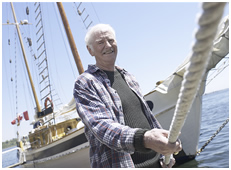|
 Today we are going to get ready for an excursion that will take place in a few days. We are going to meet up with a group of scientists sailing a replica of the H.M.S. Beagle along its original course. Today we are going to get ready for an excursion that will take place in a few days. We are going to meet up with a group of scientists sailing a replica of the H.M.S. Beagle along its original course.
A replica is an exact copy, and the H.M.S. Beagle is just like the very ship on which Charles Darwin sailed to the Galapagos Islands so many years ago.
As you'll find out, or may know, Charles Darwin proposed the idea of evolution of species after his voyage on the Beagle as the ship's naturalist.
There are a few things we need to go over before the H.M. S. Beagle arrives.
 What Does Evolution Mean? What Does Evolution Mean?
The term evolution gets a lot of political attention in society. Let's start this activity using the definition found in Webster's Dictionary as our starting point. Access the dictionary and look up the word "evolution." You'll find several definitions. Write them down in your Travel Log and then take a few minutes to compare the similarities in each.
Webster.com
Now, if you could sum up all the definitions, or tell someone what all the definitions had in common, in one word what would it be?
In today's world of biology, there are the two basic ways evolution is used in the study of biology: Microevolution and Macroevolution
Microevolution vs. Macroevolution
Recall that living things (like bacteria, plants, and animals) are constantly changing and adapting to their environment through genetic processes. This idea of change is a theme throughout the study of biology. The term evolution is used to discuss this slow change, or development, over time.
There are two theories involving evolutionary changes in the study of biology.
- Microevolution
- Macroevolution
Before we move any further it would be helpful to define what a theory is.
Theory vs. Law

Ancient sailors, and many scientists of the day, used to think the world was flat instead of round. They thought that if they sailed to the end of the ocean they would fall off the edge. To us this idea seems quite ridiculous, but people really did believe that theory at one time.
A theory is a proposed set of statements or principles used to explain a group of facts or natural phenomena—evidences that support the theory. No matter how well one theory fits observations, upon the discovery of new evidences, a new theory might fit them as well or better. In science, the testing, revising, and occasional discarding of theories, new and old, never ends.
Scientific theories are often debated by scientist with different points of view. It is important that this happen. When the scientists compare results and points of view we come up with valuable information that often leads to important scientific discoveries.
As the research continues, it leads scientists to a better understanding of how things work in the world, but not to absolute truth. Scientific discovery is limited by technology. As technology improves, so will the evidence that supports, alters, or disputes theories of all kinds.This constant revision leads to new theories. Theories do not become laws.
In contrast, a scientific law is a conclusion that is made based on repeated scientific experimentation over many years and has become universally accepted by the scientific community. An example of a law would be the law of gravity. Laws are descriptions of specific relationships that occur in nature they do not attempt to tell us why these relationships exist just that they do.
We’d better get going to the party! If you are lucky enough to be seated at the captain’s table you will hear lots more about a few very important theories about how life began.
 Great we all made it and are lucky enough to be seated with the Captain! I would like to introduce you to the Captain of the USS La Florida, Captain Shaw. Great we all made it and are lucky enough to be seated with the Captain! I would like to introduce you to the Captain of the USS La Florida, Captain Shaw.
Hello all and welcome aboard my ship! We have so many things planned for you on your voyage. Did you know that this ship is built out of just a few basic materials, metal, plastic, glass, and rubber? Oh don’t get me wrong there are many different kinds of each of these basic ship building materials but they all fit into these few categories. Isn’t this ship a beauty!
This is much like how scientists believe life began on earth….with just a few simple things! Sit back and relax this old sailor has a few things to tell you!
Long ago, about 4.5 billion years ago, scientists believe the earth was a very rough place! It was nothing like it is today. They believe that the earth was a ball of hot chemicals and the atmosphere contained no oxygen. The scientists who believe the scientific theory of the origin of life say through several steps this inhospitable environment produced the complex cells that you are made up of today.
Find out more about this process!

Wow, thanks Captain! This is an amazing theory isn’t it? I can’t wait to get together with some ship mates and talk about it more.
Continue to the Travel Log to record your discussion with your ship mate.
Images © clipart.com 2006 with the exception of the notebook © Paul Anderson 2006
|



